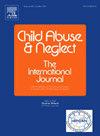Trapped in time: Time perspective explains PTSD symptom severity following childhood abuse
IF 3.4
2区 心理学
Q1 FAMILY STUDIES
引用次数: 0
Abstract
Background
Childhood abuse (CA) has profound impact on mental health, with survivors often exhibiting heightened vulnerability to posttraumatic stress disorder (PTSD). Time perspective–a psychological construct reflecting attitudes towards the past, present, and future–has emerged as a potential explanatory factor for PTSD symptoms; however, its role among CA survivors remains underexplored.
Objective
This study investigated time perspective following CA and its contribution to explaining PTSD symptom clusters, beyond known risk factors such as age, polyvictimization, the role of the perpetrator in survivors' lives, and abuse severity.
Participants and setting
The study included 977 Israeli women aged 18–70 years (M = 33.40, SD = 9.54), 80 % of whom reported a history of CA. Data were collected via an online survey.
Methods
Participants completed measures assessing CA, time perspective, and PTSD symptoms. Non-parametric tests, correlation analyses, and regression models were utilized to explore the study's hypotheses.
Results
CA survivors exhibited lower past-positive and future perspectives, higher past-negative and present-fatalistic perspectives, and greater deviations from balanced time perspective (all ps < .001, range = 0.02–0.29). Additionally, CA survivors exhibited a higher present-hedonistic perspective (p < .05, = 0.01). Time perspectives explained PTSD symptoms beyond the effects of age, polyvictimization, the role of the perpetrator in survivors' lives, and abuse severity, with varying effects across symptom clusters.
Conclusions
The findings underscore the impact of CA on time perspective and its contribution to PTSD symptomatology. Addressing maladaptive time perspectives through tailored interventions may enhance treatment outcomes for CA survivors.
困在时间里:时间视角解释童年虐待后PTSD症状的严重程度
童年虐待(CA)对心理健康有着深远的影响,幸存者往往表现出对创伤后应激障碍(PTSD)的高度脆弱性。时间观——一种反映对过去、现在和未来态度的心理构念——已成为PTSD症状的潜在解释因素;然而,它在CA幸存者中的作用仍未得到充分探讨。目的:在年龄、多次受害、施暴者在幸存者生活中所扮演的角色和虐待严重程度等已知危险因素的基础上,探讨CA后的时间视角及其对PTSD症状群的解释。该研究包括977名18-70岁的以色列女性(M = 33.40, SD = 9.54),其中80%报告有CA病史。数据通过在线调查收集。方法参与者完成了CA、时间视角和PTSD症状的评估。采用非参数检验、相关分析和回归模型来探讨研究的假设。结果a型幸存者表现出较低的过去积极观和未来观,较高的过去消极观和现在宿命论观,与平衡时间观的偏差较大(p <;.001, εH2范围= 0.02 ~ 0.29)。此外,CA幸存者表现出更高的现在享乐主义观点(p <;0.05, εh2 = 0.01)。时间视角解释了创伤后应激障碍的症状,而不是年龄、多重受害、施暴者在幸存者生活中的角色和虐待严重程度的影响,在不同的症状群中有不同的影响。结论CA对时间观的影响及其对PTSD症状的影响。通过量身定制的干预措施解决适应不良的时间观点可能会提高CA幸存者的治疗效果。
本文章由计算机程序翻译,如有差异,请以英文原文为准。
求助全文
约1分钟内获得全文
求助全文
来源期刊

Child Abuse & Neglect
Multiple-
CiteScore
7.40
自引率
10.40%
发文量
397
期刊介绍:
Official Publication of the International Society for Prevention of Child Abuse and Neglect. Child Abuse & Neglect The International Journal, provides an international, multidisciplinary forum on all aspects of child abuse and neglect, with special emphasis on prevention and treatment; the scope extends further to all those aspects of life which either favor or hinder child development. While contributions will primarily be from the fields of psychology, psychiatry, social work, medicine, nursing, law enforcement, legislature, education, and anthropology, the Journal encourages the concerned lay individual and child-oriented advocate organizations to contribute.
 求助内容:
求助内容: 应助结果提醒方式:
应助结果提醒方式:


